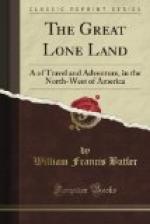For some eighty years after this settlement on James’s Bay, the Company held a precarious tenure of their forts and factories. Wild-looking men, more Indian than French, marched from Canada over the height of land and raided upon the posts of Moose and Albany, burning the stockades and carrying off the little brass howitzers mounted thereon. The same wild-looking men, pushing on into the interior from Lake Superior, made their way into Lake Winnipeg, up the great Saskatchewan River, and across to the valley of the Red River; building their forts for war and trade by distant lake-shore and confluence of river current, and drawing off the valued trade in furs to France; until all of a sudden there came the great blow struck by Wolfe under the walls of Quebec, and every little far-away post and distant fort throughout the vast interior continent felt the echoes of the guns of Abraham. It might have been imagined that now, when the power of France was crushed in the Canadas, the trade which she had carried on with the Indian tribes of the Far West would lapse to the English company trading Into Hudson Bay; but such was not the case.
Immediately upon the capitulation of Montreal, fur traders from the English cities of Boston and Albany appeared in Montreal and Quebec, and pushed their way along the old French route to Lake Winnipeg and into the valley of the Saskatchewan. There they, in turn, erected their little posts and trading-stations, laid out their beads and blankets, their strouds and cottons, and exchanged their long-carried goods for the beaver and marten and fisher skins of the Nadow, Sioux, Kinistineau, and Osinipoilles. Old maps of the North-west still mark spots along the shores of Winnipeg and the Saskatchewan with names of Henry’s House, Finlay’s House, and Mackay’s House. These “houses” were the Trading-posts of the first English free-traders, whose combination in 1783 gave rise to the great North-west Fur Company, so long the fierce rival of the Hudson Bay. To picture here the jealous rivalry which during forty years raged throughout these immense territories would be to fill a volume with tales of adventure and discovery.
The zeal with which the North-west Company pursued the trade in furs quickly led to the exploration of the entire country. A Mackenzie penetrated to the Arctic Ocean down the immense river which bears his name—a Frazer and a Thompson pierced the tremendous masses of the Rocky Mountains and beheld the Pacific rolling its waters against the rocks of New Caledonia. Based upon a system which rewarded the efforts of its employees by giving them a share in the profits of the trade, making them partners as well as servants, the North-west Company soon put to sore straits the older organization of the Hudson Bay. While the heads of both companies were of the same nation, the working men and voyageurs were of totally different races, the Hudson Bay employing Highlanders and Orkney men from Scotland, and the




